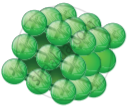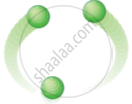Advertisements
Advertisements
Question
Distinguish the properties of solid, liquid, and gas. Draw a suitable diagram.
Solution
| S.No. | Solid | Liquid | Gas |
| 1. | Definite shape and volume | No definite shape, it attains the shape of the vessel | it has neither a definite shape nor a definite volume. |
| 2. | Incompressible | Compressible to a small extent | Highly compressible. |
| 3. | Little space between the particles | Greater space between the particles | Greater space between the particles. |
| 4. | Particles cannot move freely | Particles move freely | Particles are in a continuous, random motion. |
| 5. |
Particles in a Solid
Eg. Stone |
Particles in a Liquid
Eg. Water |
Particles in a Gas
Eg. Air |
APPEARS IN
RELATED QUESTIONS
Fill in the blanks:
Any matter which has a definite ______ but no definite shape is called a ______.
For the following statement, say whether it describes a solid, a liquid or a gas.
Particles move about very quickly but do not leave the surface
The three main states of matter are solids, liquids, and gases. Compare the three states with reference to the following characteristics of matter
(a) volume
(b) shape
(c) compressibility
(d) diffusion.
Complete the statement given below by selecting the correct word.
Solids and liquids have a definite ____ but gases do not.
State the property of the following substance.
Magnesium reacts with dilute hydrochloric acid, liberating hydrogen gas.
Which of the following is a solid?
Filtration method is effective in separating ______ mixture.
In solids, the space between the particles is less than in ______.
Complete the given analogy.
Large Inter-particle space: Gas:: ______ :solid.
Intermolecular forces of attractions are maximum in ______.



